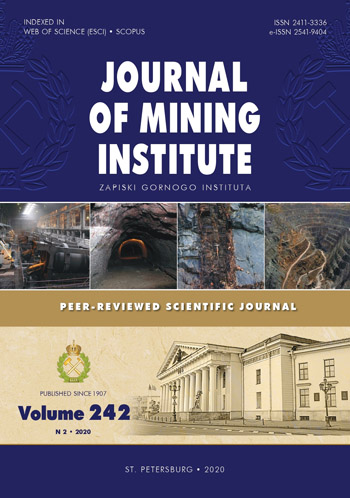Sorption of nickel (II) and manganese (II) ions from aqueous solutions
- 1 — process engineer JSC “Uralelektromed” ▪ Orcid ▪ Elibrary ▪ Scopus ▪ ResearcherID
- 2 — Ph.D. Head of Engineering Department JSC “Uralelektromed” ▪ Orcid ▪ Elibrary ▪ Scopus ▪ ResearcherID
- 3 — Ph.D., Dr.Sci. Chief Specialist JSC “Uralelektromed” ▪ Orcid ▪ Elibrary ▪ Scopus ▪ ResearcherID
- 4 — Ph.D., Dr.Sci. Head of Department Non-state Higher Educational Establishment «UMMC Technical University» ▪ Orcid ▪ Elibrary ▪ Scopus ▪ ResearcherID
Abstract
Mine water from non-ferrous metal deposits is often contaminated with nickel and manganese ions. The entry of these ions, especially nickel, into surface waters and underground aquifers is undesirable since it has a negative effect on living organisms and worsens the condition of drinking water sources. One of the promising methods for selectively extracting nickel ions and obtaining an eluate suitable for further use is sorption by weakly acid cation exchangers with chelate groups of iminodiacetic acid. As part of the study, sorption isotherms of nickel and manganese ions by Lewatit MonoPlus TP 207 cation exchanger in mono- and bicomponent systems were obtained. In monocomponent systems, the maximum static exchange capacity (SEC) of the cation exchanger for nickel ions is 952 mmol/dm3, and in bicomponent systems – 741 mmol/dm3; for manganese ions– 71 mmol/dm3 and 49 mmol/dm3, respectively. It is obvious that the studied cation exchanger has a greater capacity for nickel ions than for manganese ions. The influence of a temperature increase from 300 to 330 K on the sorption of nickel and manganese ions was established: in monocomponent systems, the maximum degree of extraction of the former increases from 65 to 77 % (SEC from 337 to 399 mmol/dm3), and the latter from 21 to 35 % (SEC – from 140 to 229 mmol/dm3); in bicomponent systems, the extraction of nickel ions increases from 59 to 78 % (SEC – from 307 to 429 mmol/dm3), and manganese ions decreases from 20 to 17 % (SEC – from 164 to 131 mmol/dm3). The predominant increase in the indicators is due to the filling of the sorption centers of the ion-exchange resins, which are energetically unfavorable for the exchange of counterions at a lower temperature. The influence of the pH of the solution on sorption was determined: the intensification of the process for nickel ions is observed in the pH range of 8.0-8.5 in a monocomponent solution and 8.0-9.0 in a bicomponent solution, for manganese ions in the range of 8.0-9.5 in both cases. The increase in the degree of extraction of ions and the exchange capacity of the ion exchanger with increasing pH is associated with the appearance of singly charged hydroxocations, dissociation of the functional groups of the sorbent and, to some extent, with the subsequent formation of insoluble forms of nickel and manganese. However, with increasing pH, a decrease in the selectivity of nickel extraction is observed: the ion separation coefficient decreases from 14.0 to 6.0 in the pH range of 6.0-11.0.
